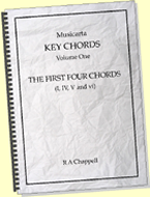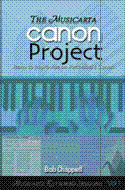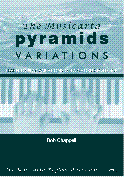|
Comptine – Yann TiersenLESSON TWOThis is Lesson Two of the Musicarta.com Comptine mini-series. Please do Lesson One first – the Comptine tab in the navbar will take you there or you can click through here. If you are continuing the Lessons, warm up by recapping Lesson One anyway. Note: The following material is for personal study use only. Respect artist’s copyright and always conform to the copyright legislation of the country you live in.
|

|
Buy the digital sheet music (published by Music Sales) from www.musicroom.com via this link, or buy it in a book - Yann Tiersen: Six Pieces Pour Piano - Volume 2, Editions Bourgès - also from http://www.musicroom.com
Buy the soundtrack (released by Virgin Records) from your favourite online store. |
Using MIDI files to help you learn
To benefit, you need to download the files and have an application that can play them. Musicarta recommends MidiPiano, a small, free, reliable application that's easy to download and use. Learn more about playing Musicarta MIDI files here. Download the MIDI files for this module here.
Please take the time to download MidiPiano and the module MIDI files! You only have to do it once, and it will prove a valuable addition to your learning resources. If you need help ‘unpacking’ your zipped MIDI file folder, there are full instructions on the Musicarta MidiPiano page (link via navbar).
Note: All Musicarta MIDI files are also available via the Musicarta MIDI file download page . Bookmark and visit regularly to see what’s on offer!
Take the time to download MidiPiano and the module MIDI files. You only have to do it once, and it will prove a valuable addition to your learning resources. If you need help ‘unpacking’ your zipped MIDI file folder, there are full instructions on the Musicarta MidiPiano page (link, above left).
Note: All Musicarta MIDI files are also available via the Musicarta MIDI file download page . Bookmark and visit regularly to see what’s on offer!
The following YouTube videos use the Comptine and make a good audio source:
Stop Press! Latest Musicarta Home-study Releases!
|
The MUSICARTA 12-BAR PIANO STYLES WORKBOOK Straight blues and boogie aside, twelve-bar form and styles run like a thread through popular music and are an essential component of any popular-styles keyboard player’s bag of tricks. The twelve-bar is a perennial musical meeting place, and the Musicarta Twelve-bar Piano Styles workbook will ensure you’re never short of an idea or two of your own! |
|
|
The MUSICARTA The modes are known as scales for improvisation – and for generating intriguing chord sequences not available in the conventional major/minor key system. Here is methodical, ‘lean’ approach to building a sound and productive knowledge of modes for the modern-styles keyboard player, packed with riffs which will expand your chord vocabulary – and your stock of rhythmic keyboard skills. |
|
|
MUSICARTA EASY The Musicarta Easy Piano Style shows you how to get your hands on the keys and start making music right away! With lots of graphics, full audio and MIDI support and all the solos on Mister Musicarta YouTube, you’re sure to get some beautiful pieces into your repertoire quickly – and learn how to find the music in the keyboard for yourself. |
|
And now, on with the show!
More right hand figures
The next right hand figure is this:
|
|
YTC_M15 |
Find the right place in one of the YouTube videos listed above or in your CD track or mp3.
Here are the notes used in this section:
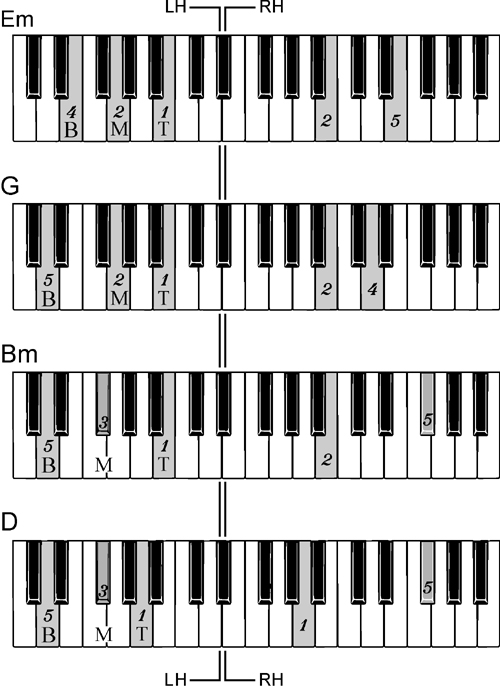
Find the notes using the keyboards and play them in the background as you listen to the audio track.
For the actual performance, the right hand plays pairs of notes – the top one first, then the bottom one. (These notes are chord tones of the E minor, G, B minor and D chords. Chord tones are always ‘first choice’ for right hand notes.)
If you listen to this section in the recorded performance, what you notice is that the second right hand note in each pair comes “off the beat”. It is ‘anticipated’ – played a quaver beat earlier than you expect.
Your shorthand sketch for working out how to play it might look like this::
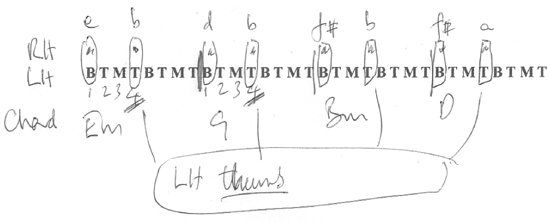
The listener has counted off the quavers and realised that the second note of each pair comes on the fourth quaver beat – which is the top (T) note of the left hand pattern, that is, always the thumb.
Using the keyboards and the shorthand sketch, copy the audio file and play the section. Here's the audio file again:
|
|
YTC_M15 |
This next section offers the chance of creating variations on this pattern. You can skip this section if you want. If you do skip forward, please make a point of coming back some time for a look!
The right hand in the section you’ve just learned plays pairs of chord tones of the four chords – Em, G, Bm, D, You can easily make a variation on this section by following the rhythmic pattern but using different chord tones.
Here are the keyboards again, but this time with all the possible chord tones shaded.
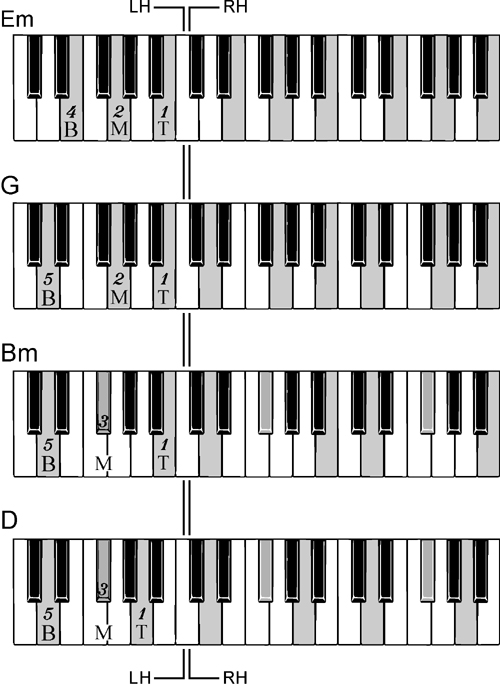
|
|
YTC_M16 |
Note that you're not expected to hold down all those notes at once - except with the sustain pedal on your piano/keyboard. You just want to 'see' the notes as available Em, G, Bm, D chord tones.
Try out any pairs of right hand chord tones (the shaded notes), playing them on the first and fourth notes of your left hand B T M T B T M T pattern. The original pairs all play highest first them lowest, but you could change that.
For ear training, try copying this audio example (before you watch the MIDI clip):
|
|
YTC_M17 |
Next, the right hand plays pairs of notes. Here are the notes used, shown on the keyboards:
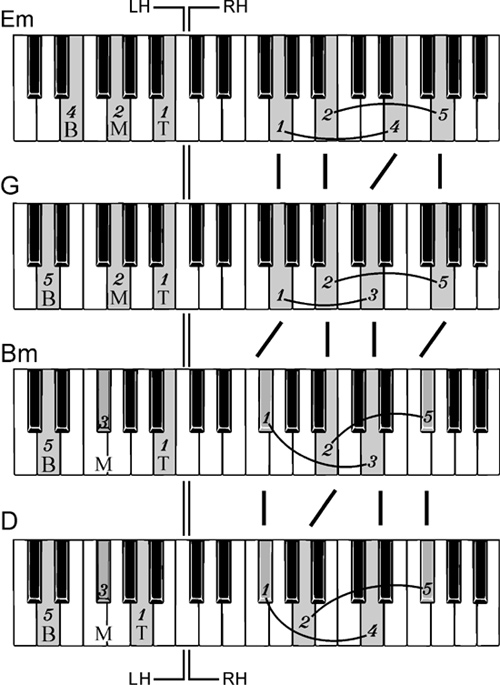
|
|
YTC_M18 |
The audio/MIDI clips are just about ‘finding the notes’, not the performance itself.
You will want to learn the four-note right hand chords on their own, using the voice movement diagrams. Use two hands and any fingers you like, and play through the four chords over and over until you know them.
- ONE THING AT A TIME!! The finger work in the right hand in this section is difficult – especially if you’re not 100% sure of the four chords. Follow the method: Learn the notes, learn the fingering, 'prepare the hand’.
Here’s the performance of this section:
|
|
YTC_M20 |
The keyboards above show the pairs of notes and the fingering to use.
Broken chord practice
The right hand pairs of notes in the previous section are quite a stretch. Serious keyboard players practise arpeggio and broken chord patterns every day so they can play figures like this easily and artistically.
Here are some sample broken chord patterns for the first (E minor) chord.
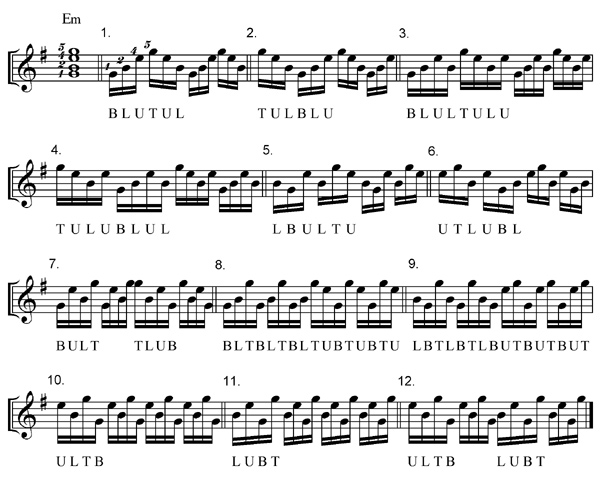
You can download this free page of broken-chord exercises from Musicarta.com.
There is no audio clip. See-and-hear the MIDI clip YTC_M21 for guidance.
Reading the practice patterns
Exercises like these can look like ‘just a mass of black dots’ – tiring to look at and very uninspiring. You have to see them as patterns in order to 'keep your head above water'. Then instead of the hundreds of notes, there are only 12 patterns.
To start seeing the patterns, read the following analysis carefully.
Four-note chords have a top (T) and a bottom note (B), and two middle notes – an upper middle note (U) and a lower middle note (L):

This is Musicarta’s BLUT shorthand for four-note chords. (Three-note chords only have bottom, middle and top - BMT.)
If you train yourself to see the chords in this way, you don’t have to read every single note of music, and you can much more easily apply the patterns to Comptine's other three chords. For example, here’s pattern 7 in E minor, then played using the B minor chord tones

|
|
YTC_M22 |
The download sheet has all four chords marked up to help you practise.
This section performance
The pairs of notes in this section come in the same rhythm as the notes in the previous section, that is, on the first and fourth quavers of the left hand BTMT pattern.
|
|
YTC_M23 |
If you can’t stretch the two pairs, here’s an alternative you might like to try.
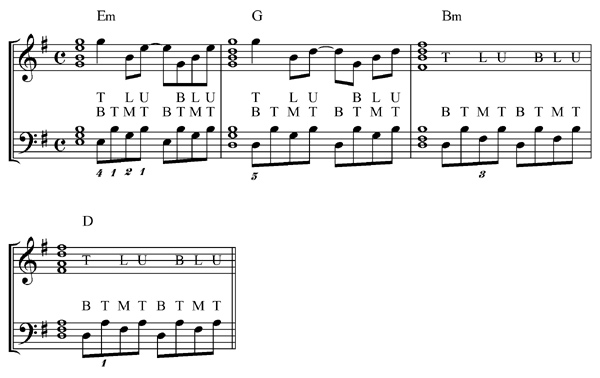
|
|
YTC_M24 |
Here’s a reminder of the four-note BLUT shorthand:

(The performance in the audio clip ‘smoothes out’ the rhythm a bit on the repeat, but the MIDI clip is metronome-accurate.)
Preparing the next patte
The next pattern is the most difficult in the whole piece. It’s the one that sounds like this:
|
|
YTC_M25 |
Here again, it’s essential to rehearse the hand positions, learn the fingering and practise jumping between the hand positions at tempo before you try to play it.
Here are the notes used shown on the keyboards. The right hand thumb uses two notes.
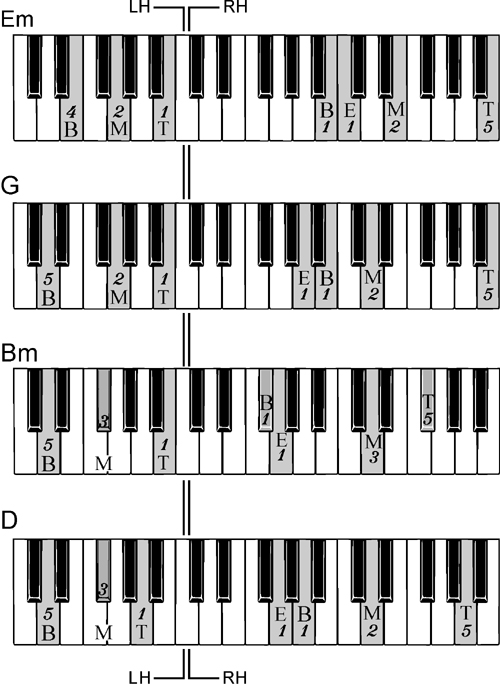
The groups of right hand notes you need to find first are the three marked B, M, T (bottom, middle, top). Use the fingering given. The other note is the extra thumb note E, which you play on its own after the BMT group.
Prepare like this:
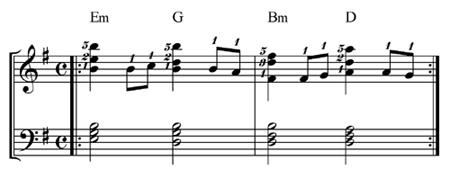
|
|
YTC_M26 |
This exercise is purely about finding the notes and hopping between positions. Rhythm is immaterial. Right hand on its own first, then with plain chords in the left hand. Next, add the left hand broken chord pattern (at practice tempo), to see if you can keep up. When it comes to changing chords at the end of the bar, you have to know which notes you’re aiming at and which fingers will play them, but in practice you throw your right hand at the next chord position position and hope for the best. Practice makes perfect!
|
|
YTC_M27 |
You can use any of these simplified ‘build-up’ versions in your interim performance. Much better to play a simplified version well than mess up the 'proper' version - or not play at all.
The full performance pattern
In the last audio/MIDI version, the last two notes before the chord changes are in the right place. One is the thumb note (marked B for bottom on the keyboards above), the other is the ‘extra thumb note’ marked E on the keyboard - for extra (not note E)
We just add a double-time 'waggle' to those two notes, using the middle note M.
Here’s an MS sketch of that:
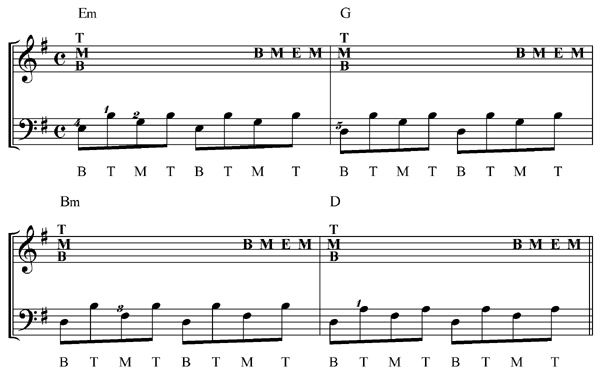
|
|
YTC_M28 |
You have to jump very quickly to the new chord at the end of the bar, because next, we are going to fill up the bar by breaking up the chord into bottom, middle, top notes (repeating) at the same speed as the last four notes. Next, see if you can repeat some of the right hand B, M, T notes without losing the left hand rhythm.
|
|
|
There are two patterns in the audio clips – both will make satisfactory interim performances. Here’s a shorthand sketch of one of them:

The full performance fills the first part of the bar (right hand) with cycling bottom-middle-top notes. Check the repeated BMT pattern in this sketch:
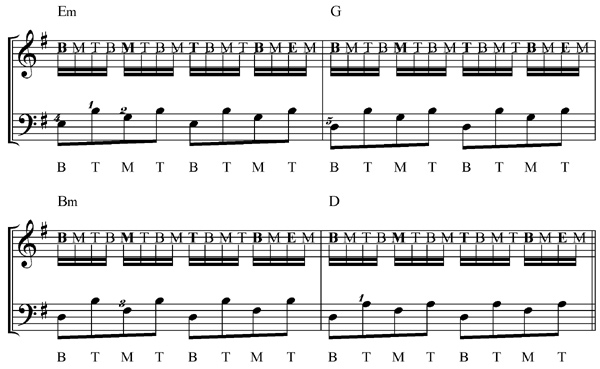
|
|
YTC_M25 |
Because there are only three notes to repeat (B, M and T) but the rhythm groups the notes in fours (as you can see), each of our three B, M, T notes gets stressed in turn (shown in bold).
You will most probably need to practise the right hand on its own. Exaggerate the stress and say out loud as you play just the right hand
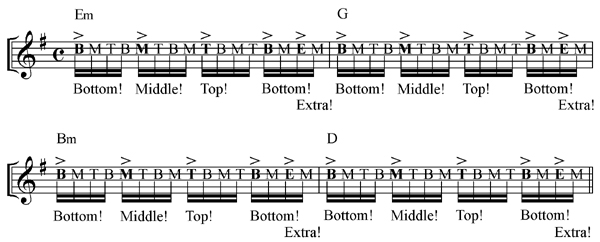
Saying out loud what you are wanting to do may feel a little unreal, but it’s a powerful technique – it calls on other parts of your brain which are already expert at what they do to help you.
Do the same measured one-handed performance as you look carefully at the way the notes are beamed (joined) together here.
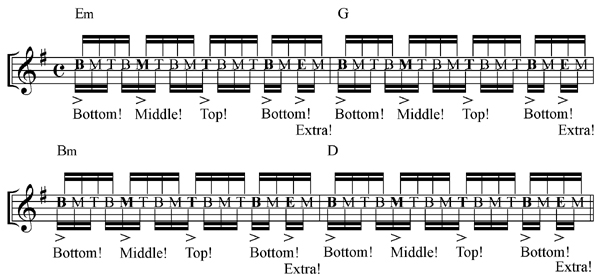
This beaming makes it clear that you play through the bottom-middle-top cycle four times to fill the first three beats in the bar. This is the secret to getting this difficult but attractive pattern right.
Now back to the full two-handed version:
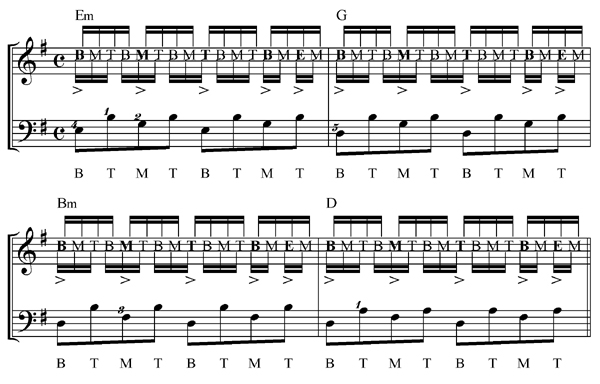
|
|
YTC_M25 |
On to the end
The recorded versions of the Comptine then repeat everything – from where the right hand starts playing a separate tune – an octave higher. Listeners are not bored by hearing the same music an octave higher – it’s a great way of getting a longer performance out of what you can play.
When you get to the end of the most complicated section (the last one you learned, above, but an octave higher) finish by slowing down a lot and playing a simple, final E minor chord – E and G in the right hand and B and E in the left, reading down from the top.
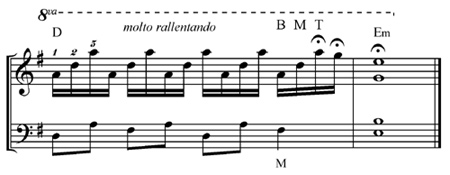
Ear training - sample variations
The aim of Musicarta’s combination of text, graphic and audio.MIDI resources is not only to create good free piano lessons online, but also to put you, the player, in charge of the music.
Playing from memory is a large part of this. Printed music tends to monopolise your attention, when it should really only be a reminder.
Playing simple variations obviously places the initiative with you, the performer, and repeating sections with simple variations offers one opportunity to ‘get into’ the music as well as making your performance longer.
Musicarta believes that you should get maximum enjoyment out of your abilities, whatever they are, but you can’t dance to a CD that jumps and sticks, and you can’t get carried away if your performance stops and starts.
Work at it ‘both ends towards the middle’. Use the simplified ‘build-up’ versions for ‘keeping-going-at-all-costs’, and while you do detailed work on the things you find difficult.
The following table contains six sample variations on the Comptine chord sequence. Listen to them carefully and try to play them by ear (there is no manuscript).
|
YTC_M31 |
YTC_M32 |
|
YTC_M33 |
YTC_M34 |
|
YTC_M35 |
YTC_M36 |
It doesn’t matter at all if you can’t get them exactly right as long as you’re trying things out at the keyboard. Relax into the idea that it might take years of ‘just messing around’ to get really good at it – but the journey’s half the fun!
Musicarta digital home study downloads
Have you enjoyed learning Yann Tiersen’s ‘Comptine’with Musicarta? Would you like to go on and compose and improvise yourself?
It’s not as hard as you might think! Musicarta has released three digital home study packs designed to structure your efforts, maximise your progress – and put YOU in charge of your own music-making!
Each package comprises:
- An illustration-rich PDF workbook of around 150 pages;
- The audio and MIDI files for all the musical examples;
- The MidiPiano application; and
- Drum and instrumental backing tracks to support you practicing and inspire your improvisations. (See individual product specs for variations.)
The three Musicarta keyboard creativity downloads are:
|
KEY CHORDS Vol. 1 Musicarta Key Chords builds your chord vocabulary by introducing the chords you are most likely to come across in any song. You practice the chord changes in contemporary riffs (drum backing tracks are included), with easy step-by-step rhythmic build-up of impressive keyboard syncopation. |
|
||
|
The CANON PROJECT Pachelbel’s Canon in D is perhaps the most famous chord sequence of all time, and the basis of dozens of popular hits. If you can play and understand the Canon chord sequence there isn’t much in popular music harmony you won’t be able to figure out. Its regular structure also make it a great springboard for improvising and composition. |
|
||
|
The PYRAMIDS VARIATIONS The Musicarta Pyramids Variations aims to exceed expectations by coaching beginners and re-starters to an impressive ‘Concert Performance’ in just eight lessons. After that, you learn a set of variations which model all the contemporary keyboard player’s knowledge and skills. |
|
Click through to the series home pages using the ‘LEARN MORE’ links. There are sample content pages to help you decide which home study pack would suit you best. They are all designed to help you enjoy becoming a creative modern keyboard player!
Thanks for visiting Musicarta.com! Come back soon!
|
|
|
|
PUBLICATIONS
exciting digital
home study packs!
BEAT AND RHYTHM
WORKBOOK


12-BAR PIANO
STYLES WORKBOOK


MUSICARTA MODES
WORKBOOK

MUSICARTA EASY
PIANO STYLE

CANON PROJECT

VARIATIONS
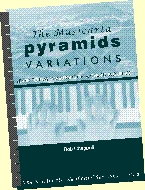
KEY CHORDS VOL.1






